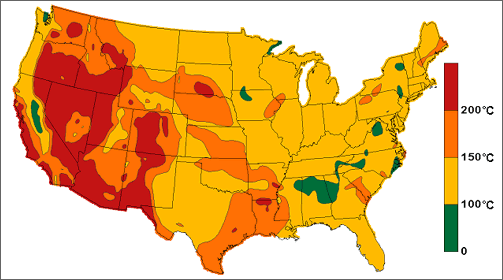In 2009 U.S. geothermal capacity grew by 6% with the addition of 6 new plants. [1] While current capacity (+3,000 MW) is a mere drop in the bucket for U.S. power generation, there is good potential for growth as a renewable energy source. As shown in the map below, the most attractive geothermal resources are heavily concentrated in the western United States.

Geothermal power is extracted from heat stored in hydrothermal resources in the earth. Hydrothermal resources are reservoirs of steam or hot water that occur naturally where magma comes close enough to the surface to heat ground water trapped in fractured or porous rocks, or where water circulates at great depth along faults. Most electricity-producing geothermal resources have temperatures from 300 to 700 Fahrenheit. However, temperatures only need to reach 220 Fahrenheit for electricity to be produced.[2] Reservoirs are either dry steam, which are rare but highly efficient at producing electricity, or hot water, which is most common and utilizes a binary cycle power plant to process the water into steam. This video below illustrates the energy conversion process.
Geothermal power plants are attractive because they are a closed loop system yet still economic in comparison to some conventional plants. According to one study, it costs 4.5 to seven cents per kWh to produce electricity from hydrothermal systems. In comparison, new coal-fired plants produce electricity at about four cents per kWh. [3] Geothermal wells and power plants must be constructed simultaneously, making construction costs quite expensive. However, fuel price volatility and transportation expense are comparatively low since the plants are literally stationed on top of their fuel source. The expectation is that, over time, the low fuel expense will balance out the high plant cost.
It all sounds great, but the binary cycle technology for geothermal plants is relatively new and industry players are still getting a feel for project economics. Fortune magazine’s article “The New, Green Land Rush” profiles Raser Technologies and their pursuit to expand geothermal capacity in the U.S. and internationally. The company’s new Thermo plant was nearly twice as expensive as the company originally estimated.
- US Department of Energy. Energy Efficiency & Renewable Energy. February 10, 2010. http://www1.eere.energy.gov/geothermal/news_detail.html?news_id=15795
- University of Colorado at Boulder. January 2009. http://lsa.colorado.edu/
- Ibid






















